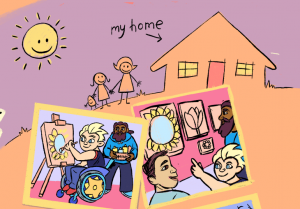
Children and young people living in residential care are some of the most vulnerable kids in South Australia’s out-of-home-care system. Compared with other children living in family-based care, they face a higher risk of physical and/or sexual abuse and emotional and psychological harm, related to their living circumstances.
For years the Guardian and others have been calling for an independent visiting scheme to monitor their circumstances and ensure they have a voice*. In 2016 Royal Commissioner Margaret Nyland agreed and recommended that the government legislate for a community visiting scheme for these children**.
How can it be that there is still no dedicated funding for regular, systematic visits to the 600+ children who are living in residential care in South Australia?
In my most recent Annual Report I reflected that a significant number of children and young people living in residential care have ongoing anxiety and depression, emotional distress, hypervigilance, eating and sleeping disturbances, self-harm and disengagement from school***. My office’s Snapshot Report on ‘Dual-Involved’ children and young people also outlined their increased risk of getting caught up in the youth justice system.
Many of these children and young people don’t know their rights and are not in contact with the Advocates in my office. Others – because they are too young or have a disability – can’t pick up a phone and ring us. Without a properly funded scheme, we cannot possibly get to them all and the oversight and advocacy we can provide will only ever represent the tip of the iceberg.
In 2020 my office commissioned a review of our work to establish a Business Case for the minimum funding needed to ‘deliver all legislated roles of the Guardian for Children and Young People’.
It included a budget of $1.637 million for a Residential Care Visiting Scheme for 400 children (the number who were living in residential care properties at that time).
A Budget for a Child and Person’s Visitor Scheme – $1.637m
- Staffing – 1 Manager, 12 Visiting Advocates
- Goods & Services – for Recruitment, Training & Development, Travel, ICT, Consumables, Business Support
- Tasks – Pre-Visit Scheduling & Preparation, Review of Records, Visit, Post-Visit Reporting, Post-Visit Advocacy & Follow-Up, Data Collation and Analysis, Systems Advocacy, Quarterly and Annual Reporting
What makes children living in residential care so vulnerable?
Stable, consistent and enduring relationships are the key to healing for children and young people who have experienced trauma. But these are rare for children in residential care because they are looked after on a ‘rotational’ basis, where a range of carers come into their homes to work on shifts. Despite attempts to have regular rosters, children can wake up to find strangers working in their home on any particular day. Many are moved from place to place as the system struggles to manage challenging dynamics between residents. When relationships are volatile or fraught they may be forced to live with ongoing conflict – or vote with their feet and leave. Children and young people in residential care make up a significant proportion of Missing Person’s Reports to police.
Despite the skill and commitment of many residential care staff, and the recent introduction of the therapeutic ‘Sanctuary’ model of care, these environments will always struggle to meet the attachment or developmental needs of children.
Time for a Visiting Scheme
The experiences of these children and young people are occurring right now, on our watch. If we are truly a civilized society we must look after the most vulnerable. That means independent eyes to see how they are faring, independent ears to hear their voices and strong advocacy when things need changing. The case for a Visiting Scheme is compelling.

Penny Wright – Guardian for Children and Young People
————————–
Background – the Nyland Royal Commission and the 2017 ‘Safety Act’
In 2016 the Royal Commission into Child Protection Systems in South Australia (the Nyland Royal Commission) was called on the back of some the most egregious abuse of children ever witnessed in this state. The Report from the Royal Commission on SA Child Protection Systems again highlighted the particular vulnerability of children in residential care. Recommendation 137 for a community visitor scheme followed.
In 2017 the Children and Young People (Safety) Act was passed. It included a Child and Young Person’s Visitor Scheme in Chapter 9 and established the role of Child and Young Person’s Visitor to oversee the scheme. The Guardian was appointed the Child and Young Person’s Visitor in 2018 while a two year ‘trial’ scheme was underway. The trial ended in 2019. No further funding has been provided to enable regular visits to all children and young people in residential care.
Without any funding to carry out the role, I resigned as inaugural Child and Young Person’s Visitor in 2021. The role remains vacant and there is currently no dedicated funding for a Visiting Scheme.
* The Guardian for Children and Young People provided a Business Case to government about a Visiting Scheme in 2014
** Office of the Guardian, Annual Report 2020-2021 p37
*** Recommendation 137, SA Child Protections Systems Royal Commission
